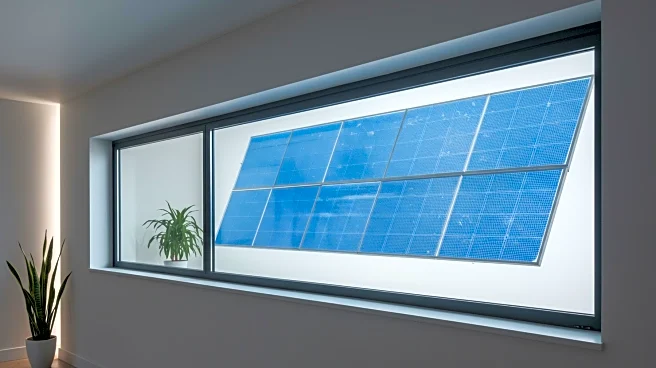What is the story about?
What's Happening?
Recent developments in semitransparent organic photovoltaics (ST-OPVs) have led to the creation of smart windows with wide geographical adaptability. These ST-OPVs manage the trade-off between photovoltaic efficiency and optical transparency, utilizing a blend of materials that optimize light utilization efficiency (LUE). The technology incorporates a ternary blend of PBOF, eC9, and PC61BM, achieving a high LUE value and improved power conversion efficiency. The smart windows are designed with thin silver electrodes and optical layers to enhance transparency and energy harvesting capabilities. The ST-OPVs demonstrate significant potential for building-integrated photovoltaics (BIPV), offering both aesthetic and functional transparency.
Why It's Important?
The integration of ST-OPVs into smart windows represents a significant advancement in sustainable building technologies. By improving energy efficiency and reducing cooling loads, these windows can contribute to lower energy consumption in buildings, aligning with environmental goals and reducing carbon footprints. The technology offers a dual benefit of power generation and thermal insulation, making it attractive for urban environments and regions with diverse climatic conditions. Industries involved in construction, renewable energy, and urban planning stand to gain from these innovations, as they provide new solutions for energy-efficient building designs.
What's Next?
The next steps involve further optimization of ST-OPV materials and designs to enhance their performance and adaptability across different climates. Research will focus on improving the durability and lifespan of these smart windows, ensuring they can withstand various environmental conditions. Additionally, efforts will be made to integrate these technologies into existing building infrastructures, potentially leading to widespread adoption in both residential and commercial sectors.
Beyond the Headlines
The cultural impact of adopting ST-OPVs in smart windows could lead to a shift in architectural design, emphasizing sustainability and energy efficiency. As these technologies become more prevalent, they may influence consumer preferences and drive demand for eco-friendly building materials. Ethical considerations include ensuring equitable access to these technologies, particularly in regions with limited resources.
AI Generated Content
Do you find this article useful?













